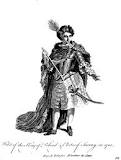 Professor Gershon Hundert, the distinguished historian and chair of the Department of Jewish Studies at McGill University, beguiled an audience of Jewish genealogists last summer in New York with midrash-like tales of early Jewish history in Poland.
Professor Gershon Hundert, the distinguished historian and chair of the Department of Jewish Studies at McGill University, beguiled an audience of Jewish genealogists last summer in New York with midrash-like tales of early Jewish history in Poland.
For centuries, the Jews felt very comfortable in Poland, Hundert said, referring to stories that even the name of the country may have derived from Hebrew. “Po-lin,” he said, may have been Hebrew for “dwell here,” while the variant “Po-lan-ya” may have meant “Here dwells the Lord.”
According to legend, a Polish king named Kazimierz took a Jewish wife named Esterka at the beginning of the 16th century. The royal couple supposedly raised their sons as Christians, their daughters as Jews.
“Esterka used her feminine charms to convince the king to let Jews into Poland,” Hundert said. Then he added, tongue-in-cheek: “The confirmation of Esterka’s historicity is the fact that you can find her grave in several Polish towns.”
Poland’s early Jews had “a low level of exilic consciousness” and hired Italian architects to design their synagogues and houses, he said. “They had about themselves a sense of permanence, as if they knew that here they would stay a long time.”
Despite invasions by Cossacks, Muscovites and Swedes, the Jews increased in number in Poland-Lithuania in the 18th century. According to a census taken about 1765, there were some 550,000 Jews in Poland and another 200,000 in Lithuania. The region was the center of the Jewish world.
“It was a massive community, growing more quickly than the rest of the population. This was not due to a higher birth rate but to a lower death rate. The incidence of Jewish infant mortality was lower.”
Why did fewer Jewish babies die? Hundert cited the strong communal support network, the relative stability of the family, the low rate of Jewish alcoholism, and the system of “kest” through which young couples were hosted by the bride’s family in the first years of marriage.
At the close of the 18th century, some 90 per cent of Poland’s Christian population were peasants living in the countryside, while the Jews lived predominately in towns. In other words, the Jewish population was essentially urban, and lived in a society that was overwhelming rural.
Many Jews preferred to live in private towns owned by magnates who protected them, but even in public towns, most taverns and stores were owned by Jews. Hundert questioned the appropriateness of the term “minority” as applied to the Jews, since only 40 to 60 per cent of the inhabitants of Poland were of Polish origin. The population was multinational.
Author of the landmark study, The Jews in a Polish Private Town: The Case of Opatow in the Eighteenth Century (John Hopkins, 1992), Hundert cited a few rare bibliographic sources for Polish-Jewish genealogy, including some private-town archives. The message for genealogists? Dogged determination, scholarship and strong linguistic skills can pay off.
With the agility of a stage magician, he closed his lecture by displaying two impressive documents. First, a page from the Warsaw census of 1765, showing a column of Hebrew-style patronymics with no modern surnames in evidence. Second, a census page listing family members of the Hassidic giant, the Ba’al Shem Tov.
For experienced researchers, the Polish census of 1765 has acquired the mythical aura of a holy grail. The historian Raphael Mahler examined it and published an analysis before the war. Since then, the census has largely disappeared: only fragments remain, mostly for towns in the east and south-east, but they’re very difficult to find. Hundert’s dogged determination and superb research skills had paid off once again. ♦
© 1999






